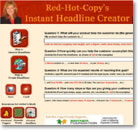Penny-pinchers. Tightwads.Cost-cutters.
Not very attractive descriptions, are they? Rather reminiscent of Scrooge in an overcoat and muffler, counting up his fortune by candlelight, perhaps?
But these words take on a new, positive meaning when you're talking about energy savings these days. It's not just the "tightwads" who are setting their thermostats to lower temperatures and adding layers of clothes, or rolling low-wattage space heaters from room to room.
As Benjamin Franklin said, "A penny saved is a penny earned." And negawatts - the energy not consumed, resulting in the dollars not spent - are the hottest new income stream. The question of the day is - how can I get the greatest value from the lowest energy expenditure?
Problem is - this is bordering on the territory of engineers, where jargon and technical specifications can confound the average consumer.
Are You Selling What Your Customers Want To Buy?
When you're a green company targeting a shivering clientele - whether you're selling pellet stoves, biobased insulation, or tankless water heaters - the key to your success is simple: How well are you communicating the benefits of your product?
Floor-walking sales staff have known for years - sell the benefits, don't drone on about the specs. Educate customers through the buying process, making sure they have all the information they need to make a good decision.
But how do you translate this to online shopping? The concepts are very much the same.
How Will Your Product Make a Difference In Their Lives?
Most online shoppers don't want to be immediately confronted with a long sales page that overwhelms them with industry jargon, long lists of features or specifications ...or even technical terms. What's a BTU? How does it relate to a watt? How do you figure BTUs per square foot? How (yes, really) do you figure the number of square feet to a room or home?
Sure, you'll always get a few informed buyers who have done their homework and want to skip right away to compare product features. But for many consumers, the question is - how much value will this product give me for the money I'm putting out? And specifically - how fast will it pay for itself in energy savings? Compared to this, everything else is embellishment. They're looking for the big picture, the concepts, not the details yet.
Answer The Important Questions First, Then Give The Details
So give the big picture first. Load your product page with the benefits - the practical impact on the buyer's life - not features. If the product will keep them warm for pennies per day, say so! Describe its energy consumption with easy comparisons: for example, "hour for hour, equivalent to running a ceiling fan." Communicate in ordinary, conversational terms...the language your customers speak.
List the features and specs? Of course - but not on the first page your prospect sees. Make them easily available, but not intiimidating. Think of the first questions your customers ask, and put those answers at the top: the product's Energy Star rating, for example.
Make It Easy and Convenient
Don't assume anything. Make the process as convenient as possible. Even if a consumer knows how to figure the number of square feet per room or watts per BTU, for example, you'll win points if you provide a handy online calculator that will keep them from reaching for the pencil and paper.
Include customer ratings and reviews for the product, if possible, as well as text fields where new buyers can give their own feedback, and/or ask questions. Realize that most consumers shop around, visiting several websites before they settle on one vendor. Make it easy for them to come back to you with a bookmark or a wish-list email.
Be The Expert Resource They Can Trust
Most important: demonstrate that you understand their comparison shopping. Offer your visitors a free report listing, say, the 10 questions they need to ask to get the best product for their needs. Make it an incentive to opt into your email list, and be sure to check in with them a few days later, to offer further information or support if they need it.
The less you assume, the more you educate, the more your clients will trust you. Help them to understand the high value of your product with high-value content.
Sunday, October 18, 2009
Selling High-Tech Products to Non-Technical Buyers
Posted by
Phila Hoopes
at
1:43 PM

![]()
Labels: cleantech, green business, green copywriting, technical copywriting
Subscribe to:
Post Comments (Atom)







No comments:
Post a Comment